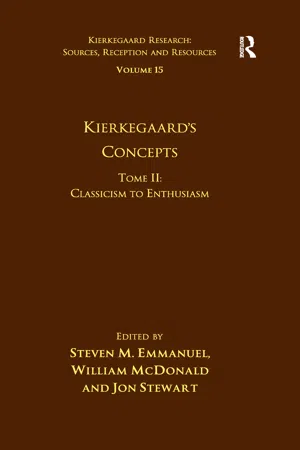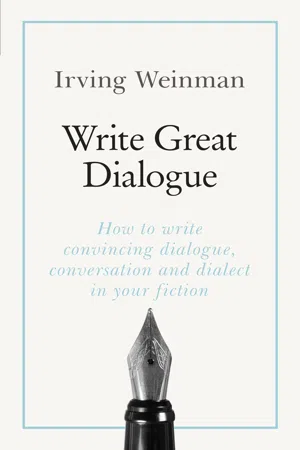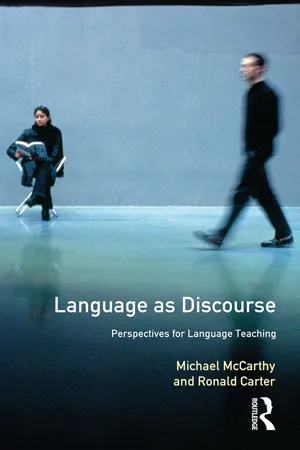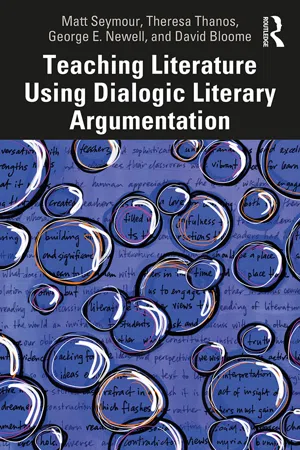Dialogue
Dialogue in literature refers to the conversation between characters, often used to reveal their thoughts, emotions, and relationships. It serves to advance the plot, develop characters, and create a sense of immediacy and authenticity in the narrative. Well-crafted dialogue can also convey subtext, conflict, and thematic elements, enriching the overall storytelling experience.
6 Key excerpts on "Dialogue"
- eBook - ePub
Volume 15, Tome II: Kierkegaard's Concepts
Classicism to Enthusiasm
- Steven M. Emmanuel, William McDonald(Authors)
- 2016(Publication Date)
- Routledge(Publisher)
...Dialogue Irina Kruchinina Dialogue (Dialog —noun; Samtale —noun; samtale —verb) The Danish word Dialog is identical in meaning to the English word “Dialogue.” Both derive from the Greek διάλογος —a verbal interaction between two or more persons. Dialogue is contrasted with monologue and also with a coherent sequence of questions and answers that touches upon the issue but does not personally concern the speakers. Dialogue emphasizes the interaction of several people in a conversation. In aesthetic terms, Dialogue is defined as a literary form, for example, in dramatic works. 1 Kierkegaard presents the concept of Dialogue in relation to the oppositions: discourse, speech (Tale)/conversation (Samtale), and “to become involved with you” (at indlade sig med Dig)/chatter (Passiar). I. Socratic Dialogue Kierkegaard uses the term “Dialogue” most often to define the genre of literature developed in ancient Greece that presents a written discussion of moral and philosophical problems. Kierkegaard made a deep and elaborate analysis of Plato’s Dialogues in his dissertation The Concept of Irony. Kierkegaard revives the Socratic Dialogue in his concepts of indirect communication and reticence. This Dialogue is an interaction between a wise speaker and perceptive listeners. The speaker refrains from forcing a truth directly on others as a doctrine so that the listener (or the reader) can work out the meaning of life for himself. A variation on this theme is found in the concept of truth as subjectivity developed in the Concluding Unscientific Postscript. According to Kierkegaard, truth is a matter of finding that truth which is a truth for the individual speaker and for every single reader. The aim of Dialogue, which is truth, puts its participants into a common context of personal responsibility for the content of the Dialogue. The latter is a question of each listener’s personal response to relate with conviction to the speech of the wise speaker...
- eBook - ePub
Write Great Dialogue
How to write convincing dialogue, conversation and dialect in your fiction
- Irving Weinman(Author)
- 2019(Publication Date)
- Teach Yourself(Publisher)
...5 Versions of Dialogue In this chapter you will learn: • About different ways of presenting Dialogue • How letters can create the effect of Dialogue • How journals and diaries can be used to present Dialogue • How telephone Dialogue can reveal character. This chapter looks at the main versions or formats in which Dialogue can be presented other than as direct Dialogue as discussed in the three previous chapters. It’s worth remembering as you read this chapter that it is not an academic survey of a subsection of fiction as literature. It’s a practical presentation of the various formats you can use to present (to represent) Dialogue. Some of the ways are very old, some are very new, all are potentially very useful to your writing. While it’s obvious that Dialogue can be presented in letters, can letters themselves be regarded as Dialogue? Short answer: no, and in some ways yes. As Dialogue in fiction is defined to be the representation in writing of people speaking, letters in fiction as the representation of people writing cannot be Dialogue. Nevertheless, fiction is a set of conventions, constantly changing yet just as constantly incorporating past conventions found to be useful to writers. One of the earliest of these conventions is that of the novel written entirely as a series of letters between characters and as a journal kept by the central letter-writing character. The earliest of these novels, Pamela, by Samuel Richardson, was published in 1740 and was a sensational success...
- eBook - ePub
Language as Discourse
Perspectives for Language Teaching
- Michael Mccarthy, Ronald Carter(Authors)
- 2014(Publication Date)
- Routledge(Publisher)
...Dramatic criticism has tended to concentrate on the verbal content of character speech but a little thought will reveal how significant such aspects of turn-taking can also be for the interpretation by an audience of a speech situation (see Herman 1991). Dramatic Dialogue is, on one level, tidied up talk; otherwise, an audience would not be able to follow the movement of a play. But it is also clear that dramatists will employ all the resources available to them for the practice of their art. In particular, they may ‘overload’ their discourse, so that the basic information content of a Dialogue is supplemented by a wealth of other rhetorical and dramatic devices in order to provide as dense and rich a set of possibilities for interpretation as is commensurate with the dramatist’s intention. In this connection, we can learn a lot about the management of ‘ordinary’ conversation by studying the way in which the rules and conventions of such discourse are creatively exploited by the great dramatist. This is also one of the main reasons why drama texts can be used to considerable effect in contexts of language teaching, especially the teaching of a second or foreign language. Here is an example of a dramatist exploiting some conventions of turn-taking. The extract comes from Alan Ayckbourn’s Woman In Mind (1986). Susan, the main character, suffers an accident which leaves her in a disturbed mental state. She ‘imagines’ a parallel family to her real family. Her real husband is Gerald; the other characters are fantasy characters. Note how it is the turn-taking that suggests the irreality of the characters...
- Matt Seymour, Theresa Thanos, George E. Newell, David Bloome(Authors)
- 2020(Publication Date)
- Routledge(Publisher)
...3 READING AND WRITING ABOUT LITERATURE AS SOCIAL AND DIALOGIC Underlying Dialogic Literary Argumentation is an understanding of reading and writing as social and dialogic. Reading is social because when we read, we do so with others. It may be that we are reading at the same time and in the same place as others (as might occur when a class is reading a literary text together) or it may be that we read in isolation (perhaps at home, by our self, deliberately separate from others) and then later talk with others about what we read (as might occur when there is a homework assignment to read a literary text and then come to class the next day to discuss what has been read). Regardless, it is social. And, of course, we read what others from the past and the present have written and thus have a social relationship with authors. Writing, too, is social. We write to others. We write to communicate information to them, to get them to do something, to share a story we have heard or imagined, to build a relationship with others, to get our personal and social needs met, and to engage others in learning about and inquiring about something we want to explore. Each act of reading and writing is an opportunity not only to take up what went before but to “refract” it. Reading and writing are also dialogic. Any time we read or write, we are responding to something that has gone before or something that we are anticipating in the future. This is easiest to see in writing. Someone has done or said or written something and we write as a way of responding to it. And while it is not as common to view reading the same way, reading is also a response. Someone has written a letter to us and so we read as a response to getting that letter...
- eBook - ePub
Overcoming Polarization in the Public Square
Civic Dialogue
- Lauren Swayne Barthold(Author)
- 2020(Publication Date)
- Palgrave Macmillan(Publisher)
...Dialogue, on the other hand, utilizes narratives based in first-person experience, encourages genuine questions of curiosity to promote deeper reflection and expose gray areas, and aims at mutual understanding. Diana Eck, who developed the Pluralism Project at Harvard, explains the essence of Dialogue this way: “Dialogue is the process of connection …. Dialogue is premised not on unanimity, but on difference. Dialogue does not aim at consensus, but understanding. Dialogue does not create agreements, but it creates relationships” (Eck 2005, 28). I will distill the differences between Dialogue and forms of discourse like debate and deliberation into four main themes. First, the emphasis in Dialogue is on listening and asking genuine questions rather than on asserting propositions aimed to persuade the other of the correctness of one’s own views. Second, Dialogue does not rely on rational justifications and reasons that all can accept but draws on first-person perspectives and narratives. Third, rather than focusing on evaluating policy options or utilizing persuasion to obtain consensus on policy, Dialogue invites an openness to explore the tacit tensions and overlooked uncertainties that expose the gray, in-between areas of particular positions and policy. Fourth, it uncovers deeply held values, and personal hopes and fears, of both oneself and the other, that ultimately serve both to reveal and foster an underlying common humanity. Even though Dialogue is not debate, deliberation, mediation, or problem solving, its political relevance lies in its capacity to function as “a prelude” to these more typical political forms of discourse (Herzig and Chasin 2006, 3). Dialogue that aims at fostering connections with the other can lead to “reducing the likelihood of gridlock in the halls of Congress, hatred in the arena of public opinion, and potentially dangerous misrepresentations in our sound-bite saturated media” (1)...
- eBook - ePub
- Steven A. Stahl, David A. Hayes, Steven A. Stahl, David A. Hayes(Authors)
- 2013(Publication Date)
- Routledge(Publisher)
...Focusing on the questioning process also provides teachers with opportunities to make students aware of multiple ways of reading any text. Dialogical teaching involves using questions both to listen to what students are saying about their reading as well as to open up new lines of inquiry students may not be aware of, but may be ready to take into consideration. In-Role Speaking and Writing Reflecting on my own early experiences with eliciting student responses leads me to concur with Thomson (1987)—that “the activities of reading literature and discussing it with others are not sufficient of themselves to ensure that students will extend and refine their understanding of themselves and of other people and the human condition” (p. 135). Teenagers all too easily embrace the notion that similarities and differences among readings do not really matter—that, because “everyone has their own opinion,” there’s no point in going further than granting everyone an opportunity to “say what they think.” This notion evaporates when students are convinced that learning about themselves and making meaningful connections with others may be legitimate purposes for reading in a setting that supports Dialogue. A powerful alternative to focusing exclusively on questions is to have students situate themselves as readers by attempting to imagine how others—including the implied author, fictional characters, and other readers—could be situated with regard to a particular text. Thomson underscored the power of verbal and written role playing to encourage self- and otherawareness. Once a person begins to improvise action and words around a fictional scene or character, she begins to give that character life from within herself, to the considerable increase of her own understanding and involvement...





